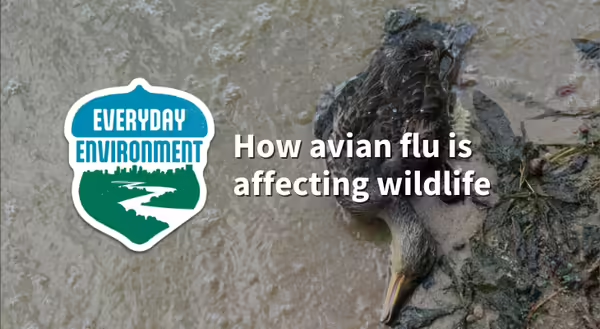
In early February, dead birds began washing up on the Chicago lakeshore: red-breasted and common mergansers, Canada geese, and others. In a city where frequent songbird window strikes are unfortunately common, the die-offs of water birds are particularly alarming.
The nationwide spread of highly pathogenic avian influenza, HPAI, also known as avian flu or bird flu, has many concerned about livestock, food safety, and public health. You can read more about HPAI in the article What to know about avian flu in wild birds, poultry, and pets in Illinois, but we wanted to explore the science behind how this virus is affecting wildlife and what you can do.
Still have questions? You can always connect with staff in your local University of Illinois Extension office for guidance.
What is avian flu?
HPAI spreads among wild waterbird species and can spread to domestic birds. In domestic poultry, HPAI is an extremely contagious disease that primarily affects the respiratory and neurological systems and is often fatal in birds. It can kill entire flocks in a matter of days.
A new avian flu outbreak was first detected in the U.S. in January 2022, affecting 156 million domestic poultry so far, according to the USDA Animal and Plant Health Inspection Service. The H5N1 virus has been moving from wild birds into poultry flocks for four years; historically, outbreaks only circulate for one season. Reported cases have increased in the past few months, and one of the current strains of the virus, H5N1, has also spread to mammals — including dairy cattle, wild carnivores, and pets — raising concerns about how the virus might be mutating.
How does avian flu affect wild birds? Should I take bird feeders down?
Bird flu is not common in wild birds, but it is more likely to be found where there are large concentrations of birds, said Joy O'Keefe, associate professor and Extension wildlife specialist in the department of natural resources & environmental sciences. It mostly affects waterfowl — ducks, geese, swans — gulls, terns, and shorebirds. Crows and raptors can also carry it. The Cornell Lab of Ornithology has a full list of species of birds affected by avian flu. Aquatic birds that traditionally migrate away in winter may not if temperatures are warm enough that lakes and ponds do not freeze over, allowing them to gather.
Songbirds are not as likely to be affected by bird flu. The Cornell Lab has been monitoring developments with the APHIS National Wildlife Disease Program and notes that songbirds make up 3% of all reported cases of avian flu. The USDA does not recommend removing sources of food, water, and shelter for wild songbirds unless you also take care of poultry.
“While avian influenza is unlikely to appear in wild bird populations in backyards, it is always a good idea to regularly clean feeders to prevent the spread of other pathogens, like salmonella,” O’Keefe said.
Michael Ward, a professor of natural resources and environmental sciences, explores more about the impact in an interview, How are migrating wild birds affected by H5N1 infection in the U.S.?
Does bird flu affect mammals?
There have been documented cases of avian flu in foxes, bobcats, skunks, and other carnivores that prey on dead birds. Dr. James Lowe, University of Illinois professor of veterinary clinical medicine, said scientists theorize the virus transfers from birds to mammals through exposure to bird feces. Lowe said the impact of the virus also varies by species, causing widespread death in some animals while barely affecting others. In some carnivorous mammals – cats, foxes, opossums – the virus affects the brain and causes neurological problems, Dr. Lowe said in interviews with the U of I News Bureau. The virus can also affect marine mammals. Seals are especially vulnerable.
How many wild animals have been affected by avian flu?
It is hard to know how many wild birds and mammals have been affected. The USDA Animal and Plant Health Inspection Service is tracking HPAI in wild birds nationwide, and since January 2022, 11,627 cases have been detected. Dr. Stephany Lewis, University of Illinois professor of zoological medicine, noted in an interview that cases in wild birds are likely underreported. Not every dead bird can be accounted for, and there is not enough capacity to test and confirm the virus in every suspected case.
What should I do if I find sick or dead birds?
Wild birds that are infected may not have any symptoms. Symptoms include tremors, difficulty standing, lethargy, and cloudy eyes. Do not handle dead or dying birds, and do not send birds to veterinarians or wildlife rehabilitators. Report five or more sick or dead wild birds to a local IDNR District Wildlife Biologist or USDA Wildlife Services at 1-866-487-3297.
If you must remove a dead bird, for example, to prevent another animal from eating it, follow these guidelines from the Illinois Department of Public Health. It is unlikely handling dead birds would lead to an infection, but it is best to wear gloves, safety goggles, and a mask. Avoid touching your face and wash your hands thoroughly afterward.
How can I support wild bird populations?
The arrival of widespread bird flu is another challenge birds face on top of habitat loss, building collisions, pollution, and climate change. You can support birds by turning off lights at night, growing native plants that provide food and shelter, and providing bird feeders, baths, and houses. Find more resources for supporting wildlife on the Illinois Extension Wildlife website.